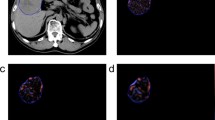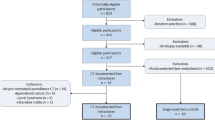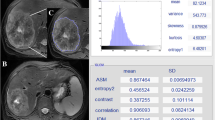Abstract
Purpose
The purpose of the study was to determine if CT texture features of untreated hepatic metastatic colorectal cancer (CRC) relate to pathologic features and clinical outcomes.
Methods
Tumor texture analysis was performed on single hepatic metastatic lesions on pre-treatment contrast-enhanced CT scans in 77 pts (mean age 58, 34F/43M) using a novel tool. Measures of heterogeneity, including entropy, kurtosis, skewness, mean, mean positive pixels (MPP), and standard deviation (SD) of pixel distribution histogram were derived with filter values corresponding to fine (spatial scaling factor (ssf) 2), medium (ssf 3, 4), and coarse textures (ssf 5, 6). Texture parameters were correlated with tumor grade, baseline serum CEA, and KRAS mutation status. Overall survival was also correlated using Cox proportional hazards models. Single-slice 2D vs. whole-tumor volumetric 3D texture analysis was compared in a subcohort of 20 patients.
Results
Entropy, MPP, and SD at medium filtration levels were significantly associated with tumor grade (MPP ssf 3 P = 0.002, SD ssf 3 P = 0.004, entropy ssf 4 P = 0.007). Skewness was negatively associated KRAS mutation (P = 0.02). Entropy at coarse filtration levels was associated with survival (Hazard ratio (HR) for death 0.65, 95% CI 0.44–0.95, P = 0.03). Texture results for 2D and 3D analysis were similar.
Conclusions
CT texture features, particularly entropy, MPP, and SD, are significantly associated with tumor grade in untreated CRC liver metastases. Tumor entropy at coarse filters correlates with overall survival. Single-slice 2D texture analysis appears to be adequate.




Similar content being viewed by others
References
Sargent D, Shi Q, Yothers G, et al. (2011) Two or three year disease-free survival (DFS) as a primary end-point in stage III adjuvant colon cancer trials with fluoropyrimidines with or without oxaliplatin or irinotecan: data from 12,676 patients from MOSAIC, X-ACT, PETACC-3, C-06, C-07 and C89803. Eur J Cancer 47(7):990–996
Van Cutsem E, Cervantes A, Nordlinger B, Arnold D (2014) Metastatic colorectal cancer: ESMO Clinical Practice guidelines for diagnosis, treatment and follow-up. Ann Oncol 25(Suppl 3):iii1–iii9
Ferlay J, Soerjomataram I, Dikshit R, et al. (2015) Cancer incidence and mortality worldwide: sources, methods and major patterns in GLOBOCAN 2012. Int J Cancer 136(5):E359–E386
Desch CE, Benson AB 3rd, Somerfield MR, et al. (2005) Colorectal cancer surveillance: 2005 update of an American Society of Clinical Oncology practice guideline. J Clin Oncol 23(33):8512–8519
Ng F, Ganeshan B, Kozarski R, Miles KA, Goh V (2013) Assessment of primary colorectal cancer heterogeneity by using whole-tumor texture analysis: contrast-enhanced CT texture as a biomarker of 5-year survival. Radiology 266(1):177–184
Ganeshan B, Miles KA (2013) Quantifying tumour heterogeneity with CT. Cancer Imaging 13:140–149
Ganeshan B, Abaleke S, Young RC, Chatwin CR, Miles KA (2010) Texture analysis of non-small cell lung cancer on unenhanced computed tomography: initial evidence for a relationship with tumour glucose metabolism and stage. Cancer Imaging 10:137–143
Ganeshan B, Goh V, Mandeville HC, et al. (2013) Non-small cell lung cancer: histopathologic correlates for texture parameters at CT. Radiology 266(1):326–336
Miles KA, Ganeshan B, Hayball MP (2013) CT texture analysis using the filtration-histogram method: what do the measurements mean? Cancer Imaging 13(3):400–406
Ganeshan B, Panayiotou E, Burnand K, Dizdarevic S, Miles K (2012) Tumour heterogeneity in non-small cell lung carcinoma assessed by CT texture analysis: a potential marker of survival. Eur Radiol 22(4):796–802
Miles KA, Ganeshan B, Rodriguez-Justo M, et al. (2014) Multifunctional imaging signature for V-KI-RAS2 Kirsten rat sarcoma viral oncogene homolog (KRAS) mutations in colorectal cancer. J Nucl Med 55(3):386–391
Yip C, Landau D, Kozarski R, et al. (2014) Primary esophageal cancer: heterogeneity as potential prognostic biomarker in patients treated with definitive chemotherapy and radiation therapy. Radiology 270(1):141–148
Zhang H, Graham CM, Elci O, et al. (2013) Locally advanced squamous cell carcinoma of the head and neck: CT texture and histogram analysis allow independent prediction of overall survival in patients treated with induction chemotherapy. Radiology 269(3):801–809
Miles KA, Ganeshan B, Griffiths MR, Young RC, Chatwin CR (2009) Colorectal cancer: texture analysis of portal phase hepatic CT images as a potential marker of survival. Radiology 250(2):444–452
Goh V, Ganeshan B, Nathan P, et al. (2011) Assessment of response to tyrosine kinase inhibitors in metastatic renal cell cancer: CT texture as a predictive biomarker. Radiology 261(1):165–171
Ganeshan B, Miles KA, Young RC, Chatwin CR (2009) Texture analysis in non-contrast enhanced CT: impact of malignancy on texture in apparently disease-free areas of the liver. Eur J Radiol 70(1):101–110
Ng F, Kozarski R, Ganeshan B, Goh V (2013) Assessment of tumor heterogeneity by CT texture analysis: can the largest cross-sectional area be used as an alternative to whole tumor analysis? Eur J Radiol 82(2):342–348
Team RDC (2014) R: a language and environment for statistical computing. Vienna: R Foundation for Statistical Computing
Ba-Ssalamah A, Muin D, Schernthaner R, et al. (2013) Texture-based classification of different gastric tumors at contrast-enhanced CT. Eur J Radiol 82(10):e537–e543
Weiss GJ, Ganeshan B, Miles KA, et al. (2014) Noninvasive image texture analysis differentiates K-ras mutation from pan-wildtype NSCLC and is prognostic. PLoS ONE 9(7):e100244
Chong Y, Kim JH, Lee HY, et al. (2014) Quantitative CT variables enabling response prediction in neoadjuvant therapy with EGFR-TKIs: are they different from those in neoadjuvant concurrent chemoradiotherapy? PLoS ONE 9(2):e88598
Ganeshan B, Skogen K, Pressney I, Coutroubis D, Miles K (2012) Tumour heterogeneity in oesophageal cancer assessed by CT texture analysis: preliminary evidence of an association with tumour metabolism, stage, and survival. Clin Radiol 67(2):157–164
Mattonen SA, Palma DA, Haasbeek CJ, Senan S, Ward AD (2014) Early prediction of tumor recurrence based on CT texture changes after stereotactic ablative radiotherapy (SABR) for lung cancer. Med Phys 41(3):033502
Yip C, Davnall F, Kozarski R, et al. (2014) Assessment of changes in tumor heterogeneity following neoadjuvant chemotherapy in primary esophageal cancer. Dis Esophagus. doi:10.1111/dote.12170
Ganeshan B, Ziauddin Z, Goh VJ, et al. (2012) Quantitative imaging biomarkers from PET-CT as potential correlates for angiogenesis and hypoxia in colorectal cancer. In: Eurpoean Congress of Radiology Conference, Vienna, Austria
Venook AP, Niedzwiecki D, Lenz H-J, et al. (2014) CALGB/SWOG 80405: phase III trial of irinotecan/5-FU/leucovorin (FOLFIRI) or oxaliplatin/5-FU/leucovorin (mFOLFOX6) with bevacizumab (BV) or cetuximab (CET) for patients (pts) with KRAS wild-type (wt) untreated metastatic adenocarcinoma of the colon or rectum (MCRC) 2014 ASCO Annual Meeting. J Clin Oncol 32:3
Heinemann V, von Weikersthal LF, Decker T, et al. (2014) FOLFIRI plus cetuximab versus FOLFIRI plus bevacizumab as first-line treatment for patients with metastatic colorectal cancer (FIRE-3): a randomised, open-label, phase 3 trial. Lancet Oncol 15(10):1065–1075
Richman SD, Chambers P, Seymour MT, et al. (2011) Intra-tumoral heterogeneity of KRAS and BRAF mutation status in patients with advanced colorectal cancer (aCRC) and cost-effectiveness of multiple sample testing. Anal Cell Pathol 34(1–2):61–66
Bossard C, Kury S, Jamet P, et al. (2012) Delineation of the infrequent mosaicism of KRAS mutational status in metastatic colorectal adenocarcinomas. J Clin Pathol 65(5):466–469
Watanabe T, Kobunai T, Yamamoto Y, et al. (2011) Heterogeneity of KRAS status may explain the subset of discordant KRAS status between primary and metastatic colorectal cancer. Dis Colon Rectum 54(9):1170–1178
Nordlinger B, Sorbye H, Glimelius B, et al. (2013) Perioperative FOLFOX4 chemotherapy and surgery versus surgery alone for resectable liver metastases from colorectal cancer (EORTC 40983): long-term results of a randomised, controlled, phase 3 trial. Lancet Oncol 14(12):1208–1215
Disclosures
Dr. Pickhardt co-founded VirtuoCTC, is a shareholder in Cellectar Biosciences, and is a consultant for Check-Cap.
Author information
Authors and Affiliations
Corresponding author
Rights and permissions
About this article
Cite this article
Lubner, M.G., Stabo, N., Lubner, S.J. et al. CT textural analysis of hepatic metastatic colorectal cancer: pre-treatment tumor heterogeneity correlates with pathology and clinical outcomes. Abdom Imaging 40, 2331–2337 (2015). https://doi.org/10.1007/s00261-015-0438-4
Published:
Issue Date:
DOI: https://doi.org/10.1007/s00261-015-0438-4




